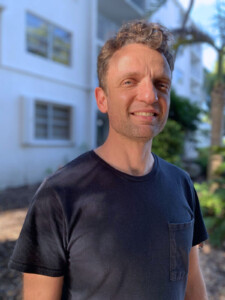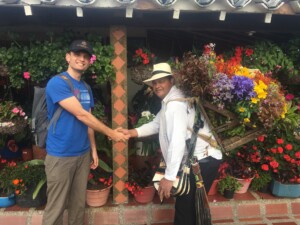Roman Yavich ‘13
M.S. ESC Water & Wetland Resource Studies

Roman Yavich
Roman Yavich ’13 was an undergraduate studying abroad in Chile when he became appalled by the vast wealth inequality he saw there. The life-changing experience spurred a twofold mission: to remediate the wealth gap and to spur similar learning experiences in other students. Eight years after receiving an M.S. from ESF, Yavich founded Learn From Travel, a mission-based enterprise that connects students and faculty from the United States with rural communities throughout the world. The goal is to build long-term relationships that provide host communities with economic resources and academic expertise, and students with access to unique local knowledge of sustainability practices, among other topics. Writer Judy Gelman Myers spoke with Yavich about the transformative experience that set him on this path, how ESF prepared him for the journey ahead, and how Learn from Travel can create a better world.
JGM: Let’s begin with your initial experience in Chile.
RY: I was working on undergraduate degrees in economics and business at the University of Colorado during which I spent a semester at the Universidad de Chile. I was struck by the inequality I saw there. Inequality is also very apparent in the U.S., but the power of study abroad is that it removes you from your comfort zone and lets you perceive things you otherwise don’t.
I moved to Buenos Aires to do a research project on income inequality in Argentina, and then I won a Fulbright to explore how tourism can help reduce inequality in Nicaragua. Through the analytical lens of tourism’s social, environmental, and economic impact, I asked how tourism could be sustainable and helpful to the host community and its people.
While in Nicaragua I co-founded a nonprofit called Comunidad Connect, which funds community development projects using revenue from college students’ service-learning projects. That’s when I became even more interested in environmental sustainability.
I returned to the States and was lucky to get a job as sustainability coordinator for a small Colorado town called Eagle. After a few years there, I decided to pursue a graduate degree.
JGM: And that brought you to ESF and Syracuse University’s Maxwell School in 2011.
RY: I wanted to continue to work in the nonprofit or public sector, and I was looking for a master’s program that combined public administration with science. I found the Maxwell School, which is right next door to ESF. I’d found the perfect degree for exactly what I wanted to do.
In ESF’s Graduate Program in Environmental Science (GPES), I worked with Chuck Kroll in the Environmental Resources Engineering department. I took classes from Charlie Hall, who analyzed the environment in terms of energy flows. I had never come across that before, and I found it a great way to think about the world and its interconnectedness. Powerful, impactful classes at ESF taught me to think differently and gave me great skills.
JGM: What inspired you to found Learn From Travel?
RY: After graduating, I found a job administering a small, privately funded nonprofit in Panama that worked on reforestation. After a few years, I returned to Comunidad Connect in Nicaragua, leveraging what I’d learned in grad school and from work. Eventually I realized I was passionate about sustainable tourism, so I split off and started Learn From Travel, my current venture.
JGM: Tell me about Learn From Travel.
RY: The company is based on a social enterprise business model—a for-profit entity that’s mission-driven. I want to provide the students with the kind of experience I had on my study abroad, which was very impactful. But I also want to provide a source of income for the people who host the students.
We organize faculty-led study abroad programs. They’re usually in rural areas with people who don’t ever work in tourism, which is what makes our programs so great. Prepackaged tourism rarely results in life-changing experiences. Our tours are very authentic, off-the-beaten-path, community-based experiences that contribute to the welfare of the host community.
JGM: How do you design your programs?
RY: We contact a university office that deals with international education. They’ll connect us with faculty who may be interested in organizing a program. The professor usually has the curriculum for a course; based on the syllabus, we design the travel itinerary.
JGM: Tell me about the sustainability component of Learn From Travel.
RY: Sustainability is at the core of what we do. First, we offset our carbon, so we’re carbon negative. Content-wise, let’s use coffee as an example. We’re currently planning a visit to Panama for Stephen F. Austin State University in Texas. The group will be looking at how to improve a strain of coffee called robusta, which is less economically desirable than arabica, the most popular coffee worldwide. The problem with arabica is that it’s very sensitive to climate. When it gets hot, arabica doesn’t produce. It’s also very sensitive to fungal and insect ailments. Robusta, on the other hand, is very robust, as the name suggests, so it can withstand heat and pests much better. This group will be learning about sustainable development priorities in this rural community and supporting an effort by their faculty leader to help a local agricultural cooperative hybridize or otherwise improve the robusta strain or cultivation process to make them more marketable.
A lot of the sustainability comes from making this not just a one-off program but something that’s annual and has additional benefits for the community. Together, the faculty and Learn From Travel are creating what we hope will be a long-term relationship between the university and the host community. Hopefully it will result in improvements to their processes and the plants they’re cultivating, which will ultimately garner more income for them on the coffee market.
JGM: What else does sustainable tourism mean for you?
RY: Educational travel is the most sustainable form of tourism because of its low impact on the environment and high impact on the social element and the local economy.
With service learning, people come down and paint a school, for instance. They think that’s a good benefit to the community, but in fact, the benefit of painting the school is marginal. The school looks better, but somebody local probably could have done a much better painting job.
I’m not opposed to painting a school, per se, if it’s in the context of a bigger impact, including a financial donation or another type of economic benefit. In our programs, the school would get resources from the university, such as a virtual education program offering opportunities for cultural exchange or language learning, experiences that can benefit the local school and the students at the university.
JGM: What other programs have you organized?
RY: We have a program in January to Mexico looking at the issue of migration from people transiting through Mexico. We’re going to visit a shelter that provides food and housing for people in transit. We’ll also meet with a professor at the local university who studies remittances because the flip coin to migration is remittances—people working in Mexico who send their earnings back home. That’s a fascinating topic in terms of economics, public administration, and public policy. The professor will arrange peer-to-peer meetings with local students.
JGM: It sounds like securing local buy-in is really critical for you.
RY: It’s all about getting people to work collaboratively with you and trying new things.
JGM: What’s your secret sauce for getting it?
RY: In the Global South, in particular, we have 500 hundred years of white people coming in and telling locals “We have a better way.” Regardless of how well-informed and well-intentioned I may be, I must acknowledge that I’m still part of that power dynamic. Being aware is the first step.
Even if you’re aware of it, and even if you try to do things differently, and try to study the lessons of the past, it’s still very common to repeat those same mistakes. It’s very difficult for several reasons. For instance, people communicate differently in different places. The magic sauce is being able to connect sincerely with people because you understand their culture, their way of communicating, and their priorities. Often, we work with local partners who help us achieve this.
Also, I speak Spanish fluently. That means I’m able to connect much better than if I spoke English through an interpreter. Being aware of local customs, traditions, culture, and speaking the local language oftentimes gets you most of the way there. Beyond that, it’s just being very respectful and humble, trusting that the locals know better than you do in regards to what they need and how things work in that place. And being willing to do it their way and understanding that you’re a visitor. If you come to people with an open mind, open arms, and an open heart, they respond to that.
I’m thankful for my background in the nonprofit world because I don’t think I would have learned some of these skills—and they are skills—in the corporate world, where everything is geared toward profit. The “if it doesn’t make dollars, it doesn’t make sense” approach limits how much flexibility you have in some of these arrangements.
Having a different attitude allows me to gain people’s trust. And because they trust us, we’re able to provide authentic experiences that are very different from what most of our competitors offer. For a program in Panama, most companies will take you to the Panama Canal or an indigenous village set up for tourism. They’re not engaged beyond the requirements for the travel program. Because they have a lot of overhead, they choose to focus on the things that make money. We have a different approach.
JGM: What’s your proudest achievement?
RY: Learn From Travel was two years old when the pandemic hit. We were just about to run our very first trips, and we had to pivot to virtual international education. I’m proud of surviving through the pandemic and seeing the business grow.
At this point, it’s hard for me to know what our impact has been on the communities and on the students. But if even one of our students ends up in the nonprofit or public sector instead of the corporate world and contributes to sustainable development, or reduction of poverty, or reduction of inequality, then that’s my proudest achievement.
JGM: Is there anything you want to add?
RY: When we talk about career, it’s hard to foresee where yours is going to take you. Multiple times in my life, I’ve had bifurcation points, where a path splits in two. My education at ESF has enabled me to have options that aren’t just linear. They outline a path that shoots off with multiple doors. The technical and scientific preparation I had at ESF gave me the options to go through any of these doors. I’m incredibly thankful for the opportunities in my life, including the education I got at ESF.
To learn more about Roman’s work, please visit www.learnfromtravel.com

While guiding a group of students learning about the cut flower business and the tradition of flower growing in Columbia, Roman Yavich ’13 met with Don Jose Angel Zapata. Don Angel is wearing a sillete, a chair with an elaborate flower arrangement which is worn during the Flowers Festival parade in Medelin, Columbia.


